
Brazilian cuisine is the set of cooking practices and traditions of Brazil, and is characterized by European, Amerindian, African, and most recently Asian influences. It varies greatly by region, reflecting the country's mix of native and immigrant populations, and its continental size as well. This has created a national cuisine marked by the preservation of regional differences.
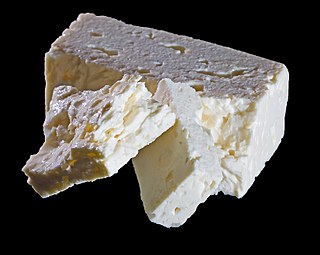
Feta is a brined curd white cheese made in Greece from sheep milk or from a mixture of sheep and goat milk. It is a crumbly aged cheese, commonly produced in blocks, and has a slightly grainy texture in comparison to other cheeses. Feta is used as a table cheese, in salads such as Greek salad, and in pastries, notably the phyllo-based Greek dishes spanakopita and tyropita. It is often served with olive oil or olives, and sprinkled with aromatic herbs such as oregano. It can also be served cooked, as part of a sandwich, in omelettes, or as a salty alternative to other cheeses in a variety of dishes.

Portuguese cuisine was first recorded in the seventeenth century, with regional recipes establishing themselves in the nineteenth century. Culinária Portuguesa, by António-Maria De Oliveira Bello, better known as Olleboma; was the first ‘Portuguese-only’ recipe book published in 1936. Despite being relatively restricted to an Atlantic, Celtic sustenance, the Portuguese cuisine also has strong French and Mediterranean influences.

Queso blanco, literally white cheese in Spanish, can refer to many different kind of cheeses whose only common trait is their white color. The specific cheese referred to depends on the region.

Minas cheese is a type of cheese that has been traditionally produced in the Brazilian state of Minas Gerais.
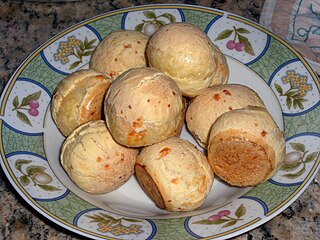
Pão de queijo or Brazilian cheese bread is a small, baked cheese roll or cheese bun, a popular snack and breakfast food in Brazil. It is a traditional Brazilian recipe, originating in the state of Minas Gerais.

Castelo Branco is a cheese named after the city of the same name in Portugal, the main city of the district where it is produced.

Danbo is a semi-soft, aged cow's milk cheese from Denmark. It was awarded Protected Designation of Origin (PDO) status under European Union law on 2017.
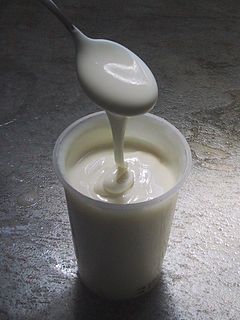
Requeijão is a milk-derived product, produced in Portugal and Brazil. It is a loose, ricotta-like cheese used to make cheese spreads. A mild, unsalty ricotta can be substituted. This variety is most often sold in the markets wrapped in fresh corn husks. In El Salvador, cheeses such as requesón can sometimes be transported wrapped in banana leaves instead.

Serra da Estrela cheese is a cheese made in mountainous region of Serra da Estrela in Portugal, which has been granted PDO status in the European Union.
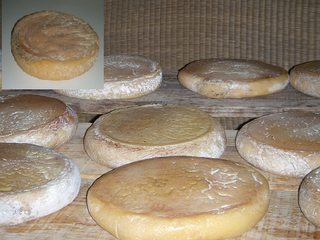
Queso de La Serena is a cheese made from Merino sheep milk in the comarca (district) of La Serena, in Extremadura, Spain. The pure sheep milk is curdled using a coagulant found in the pistils of cardoon. This ingredient lends a light bitterness to the otherwise slightly salty taste. It is aged for at least sixty days. When the cheese has a creamy consistency in the centre, it is traditionally eaten by slicing off the top and scooping out the inside with a spoon, and it is known as Torta de la Serena. If it is allowed to mature further it becomes harder, develops a stronger taste and is known as Queso de la Serena.
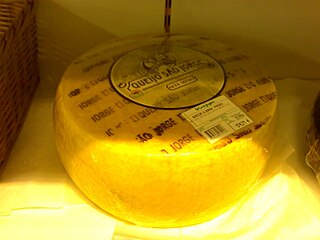
São Jorge Cheese is a semi-hard to hard cheese, produced on the island of São Jorge, in the Portuguese archipelago of the Azores, certified as a Região Demarcada do Queijo de São Jorge and regulated as a registered Denominação de Origem Protegida.
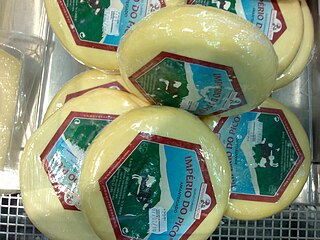
Cheese of Pico is a cheese originating from the island of Pico in the Portuguese archipelago of the Azores. It has been classified as a "Denomination of Protected Origin", in accordance with the laws of the European Union since October 1996.

Queijo de Cabra Transmontano is a type of cheese made from goat milk from Alto Trás-os-Montes, Norte Region, Portugal. It has a Protected designation of origin (PDO) and is listed on the Ark of Taste.

The Alentejo is a geographical, historical and cultural region of south central and southern Portugal. In Portuguese, its name means "beyond the Tagus river" (Tejo).

Canastra is a type of cheese from Brazil. Its name comes from the surroundings where it's produced, a highland known as Serra da Canastra, located in the southwest region of the Minas Gerais state. The climate, altitude, pasture and water of this area are specific for its manufacturing and for this reason this delicacy is only made in a handful of towns, under supervised production. In 2008 the Canastra cheese was entitled an intangible cultural heritage of Brazil.
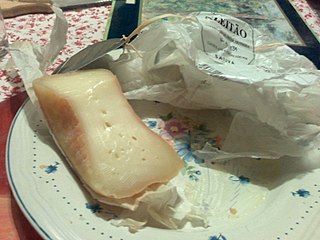
Queijo de Azeitão is a Portuguese cheese originating from the town of Azeitão, in the municipality of Setúbal. It is produced in Setúbal, Palmela and Sesimbra.

















